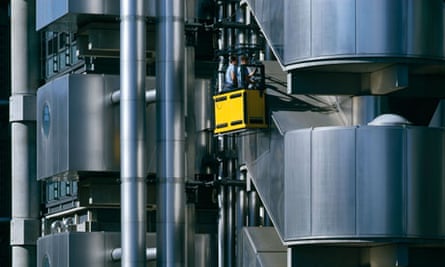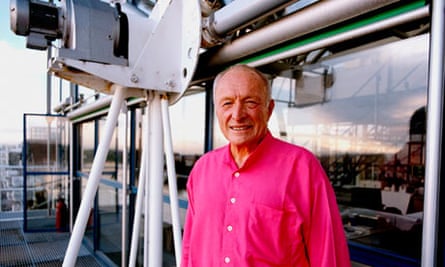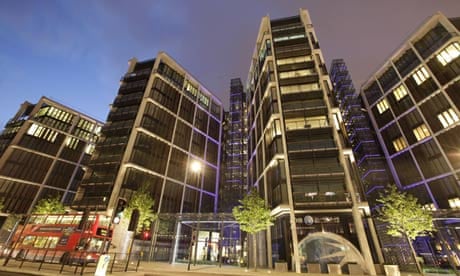In British architecture, Richard Rogers is the establishment. Inside Out, the grand exhibition at the Royal Academy in London that celebrates his 80th birthday makes this clear. He sits as a Labour peer in the House of Lords, and is officially known as Baron Rogers of Riverside – an apt title, given his pivotal role in opening up the river Thames to property development. He has sat on multiple quangos, most famously the Urban Task Force, and was a close ally both of Ken Livingstone and John Prescott before being sidelined by the coalition. Rogers had a major part in composing two government reports – Towards an Urban Renaissance and its sequel, Towards a Strong Urban Renaissance. Look at recent London schemes by Rogers Stirk Harbour, the firm he founded, and now takes a backseat role in, and you find the Leadenhall building, a skyscraper in the City; Riverlight, a development of luxury flats in Nine Elms; NEO Bankside, another development of luxury flats in Southwark; and One Hyde Park, the luxury flat development to end all luxury flat developments, a project of such spectacular exorbitance that it has been described as the most expensive apartment complex in the world. On this evidence, Rogers has a central role in a formidable apparatus of authority and capital – the old power of the Lords, the governmental power of quangos and government departments, the money power of property and real estate.
A 60th birthday exhibition for Rogers, however, would have found few of these things. In 1993, he was already a very successful and venerable architect, though perhaps a little more respected than gainfully employed, at least in the UK. His best-known works at that point were the Pompidou Centre in Paris, in collaboration with Renzo Piano (subsequent work suggests it was more Rogers's child than Piano's); the new building for Lloyds of London; and the Inmos microprocessor factory in Newport, south Wales. The diversity of that selection – a vast modern art museum, an office block for a venerable imperial financial institution, an electronics factory in an industrially depressed area – contrasts somewhat with today's record of City skyscraper, luxury flats, luxury flats, luxury flats. The extent of Rogers's intervention into politics consisted of co-writing, with then Labour shadow culture secretary Mark Fisher, a volume prepared for the 1992 election entitled A New London, which called for investment in the capital's infrastructure and architecture, both almost gleefully neglected under Thatcher. So how did the next 20 years transform Rogers's fortunes, and the firm's commissions, so comprehensively?

It would be unfair to ascribe this entirely to his long-standing Labour party membership. There's little clientelism here – Rogers has built nothing in Labour's one-party city-states such as Manchester or Glasgow. Rather it has something to do with a particular vision of urban architecture. After the Old Left's dalliance with industrialised building in the 1960s, the New Left of the 1970s was sceptical about modern architecture, and even about the modern city as such – the logical result was the rehousing programme of militant Liverpool, where modern flats in the inner city were demolished en masse, and replaced with low-density, low-rise cul‑de-sacs. For Rogers, a figure of the New Left, to the degree that he once quoted Herbert Marcuse at a Royal Institute of British Architects conference, modernism didn't have to be associated with system-built towers, windy open spaces, stained concrete, "social engineering", or all the other shibboleths hastily established as common sense in the reaction to the collapse of Ronan Point in 1968.
Rogers's work, as seen at the Pompidou Centre, did not evoke a collapsing dystopia, but a clean, shiny, optimistic, sophisticated and rather luxurious future. This wasn't the guilty, paranoid world that the New Left had bunkered itself into on the rare occasions it thought about cities and buildings – "defensible space", low-rise/low-density, "vernacular architecture", real houses for real people. Rather, Rogers's work seemed to argue, by its very exuberance and pleasure, that living in cities could be something to enjoy, not something to struggle through – a fulfilled dream of technological abundance and leisure, the very things that attracted socialists to modern architecture in the first place.
Visual pleasure and variety were always a major part of Rogers's work. His buildings of the 1970s and 80s are, in the literal sense of the word, spectacular. There would always be functional justifications for what often seem like purely visual features; in the case of the Pompidou Centre, it was apparently necessary to have the lifts, tanks, pipes and other services outside of the building to create the space for large, flexible rooms that could hold wide varieties of artworks. At Lloyds, the stated reason for the same feature was to make way for The Room, the immense space connected by escalators where most of the underwriters' business was done; in Newport, it was to reduce encumbrances to a complex production line. Yet plenty of galleries, trading floors and factories have managed perfectly well concealing these features, and hence saved themselves large maintenance bills for services bared to the elements. The reasoning was always best ignored – as the late critic Alan Colqhoun pointed out, it was implausible that any function would ever really need spaces as vast as those of the Pompidou. Their real function was awe and spectacle, and nothing much else. The accusation was surely undeniable. What the Pompidou Centre, Lloyds and Inmos offered, and still do, is an unrivalled sense of the technological sublime – the sheer futuristic joy of watching the capsules shuttle up and down the glazed shafts of Lloyds, the intricate fascination at the controlled chaos of bulging pipework on the rear facade of the Pompidou, the shock of the constructivist skyline of Inmos barging into a bland motorway-side landscape.
This was all supposed to be looked at, enjoyed, and also, understood – in the old modernist, moralist sense of "truth to materials" and "structural honesty", you could always see what the buildings were made of, what held them up, even how their circulation, electrical services and air conditioning were provided. These esoteric pleasures aside, the buildings worked in the same way as Gothic cathedrals and guildhalls – asymmetrical, heraldic, worked into compositions of skylines and towers, often crammed ingeniously into tight, constricted sites. This anti-classical, multilevel approach was something Rogers had in common with brutalists such as Rodney Gordon and Denys Lasdun, but here the obsessive attention to detail was bestowed not on cash-strapped councils, but on clients who could afford to maintain the buildings' unusual finishes – the garish Yellow Submarine colour-world of the Pompidou is always painted up, the wilfully sinister greys, silvers and blacks of Lloyds always buffed to their ruthless sheen. That two of these became tourist attractions is hardly surprising – although the fact that architectural tourism didn't extend to the outskirts of Newport should perhaps have been borne in mind. Unlike many buildings-cum-tourist attractions, they are also masterpieces, whose sophistication and intricacy long outlives the currently all important "wow factor".

Rogers himself never developed a cult of personality, unlike many in the later generation of Zaha Hadid, Daniel Libeskind at al. His drawings are always rough sketches, nothing more – each of the buildings was the obvious result of teamwork. So Rogers's extra-architectural influence is as writer, not draughtsman. The idea was always the same, and was first developed in a speculative (though not in the financial sense) scheme called London as it could be, which entailed building new pedestrian bridges and river walks along the Thames. Developed in A New London and in (among others) Architecture – A Modern View, Cities for a Small Planet and Towards an Urban Renaissance, the idea was as follows: develop the "brownfield" land left by the decline of industry, encourage people to move into the inner city, build galleries, cafes and museums, build flats and build them high and dense – but invest in public transport, public spaces and public facilities. This was in part a reaction to the way that the term "inner city" came denote a problem, a place depopulated of anyone but the very poor and very rich, the consequence both of deindustrialisation and the private car. Though Rogers's first draft of this, the Millennium Dome, was a high-profile disaster, the programme was rolled out all over the country, and in some ways we have Rogers to thank, or blame, for everything from the Tate Modern to MediaCity in Salford. During this urban renaissance, inner-city populations rose in London or Manchester, but the results mostly showed that the high-rises of Britain's builders and developers were largely as grim as their cul-de-sacs. It also accelerated processes of gentrification and expulsion of the poor, as city-centre land became more and more lucrative.
Though Rogers was unusual in his era for using "public" as a compliment rather than insult, there was a comprehensive refusal in his various writings to think about the economy, or what the likely consequences of letting developers run riot in the inner city might have been – something he had in common with his sponsors, such as Ken Livingstone. Not thinking too much about where your money is coming from is, of course, important to any architectural firm that wants to stay in business. Although Rogers Stirk Harbour refuses to design prisons or work for the military, almost any given project of the last two decades can be found to be the exact opposite of whatever Rogers was arguing for at the time in his parallel career as urban potentate. Rogers slammed the out-of-town shopping centre and then built one at Ashford; advocated low-carbon transport and designed Heathrow Terminal 5; critiqued suburbia and designed an exurban estate on the edges of Milton Keynes; criticised our barrier-riven cities and then provided the required ultra-high-security in the Welsh assembly. No surprises there – architecture is usually something between art form, profession and business. Rogers's recent legacy is a series of beautiful, unique and fascinating machines producing nothing save for money; and a series of texts that imagined a better city while refusing to admit that such a thing might involve questions of power and conflict. The firm he founded will endure as creators of the former, but the real and terrible consequences of the latter will not be solved by them.






Comments (…)
Sign in or create your Guardian account to join the discussion